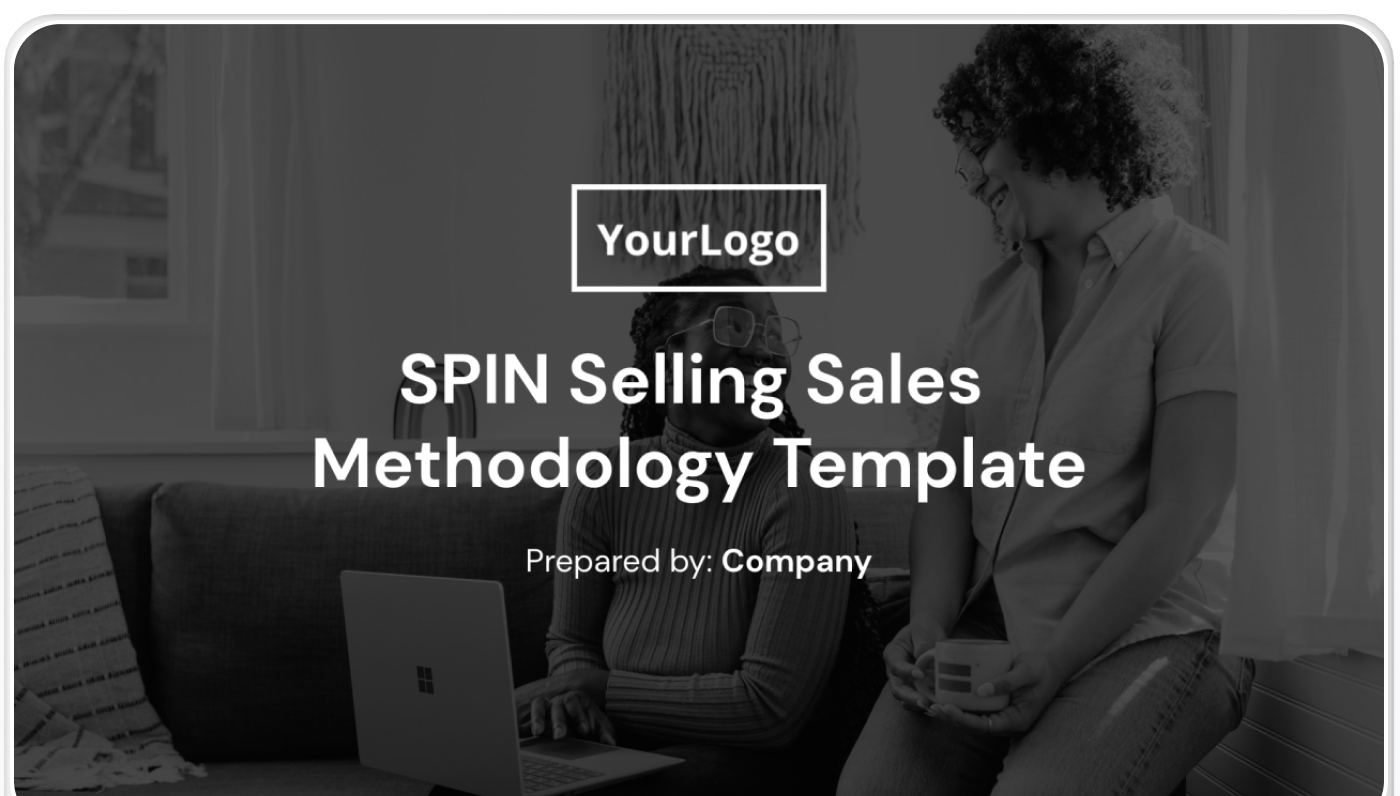
When you think about classic sales methodologies, several might come to mind. SPIN selling is one of them and it was introduced in the late 1980s.
Sales methodologies and the tools that enable them have evolved greatly since different methodologies were first used. The sales teams are structured differently, and they’re enabled with better tools and technologies - including more robust CRMs. So why are many of these classic methods still being used today?
In the case of SPIN selling, it may be because of all of the research that went into developing it and the specific way it guides sales professionals through closing deals.
What is SPIN selling?
SPIN, like MEDDIC for example, is an acronym of the sales methodology. The letters stand for situational, problem, implication, and need for payoff. In SPIN sales, sales reps organize their calls with questions that address these four areas.
The SPIN methodology was popularized by Neil Rackham’s book SPIN Selling which was originally published in 1988. Rackham was the founder and president of Huthwaite Corporation. During his time there, the company completed a 12-year, one-million-dollar study on effective sales performance. The study spanned thousands of salespeople and several countries.
In the book, Rackham explains why some sales techniques that work well for smaller deals fail when selling in an enterprise environment. He provides plenty of case studies and examples so sales reps can see SPIN selling techniques in action.
Pros and cons of SPIN selling
As with any methodology, there are pros and cons to implementing SPIN selling in your organization. In order to determine if it makes sense to move forward, sales leaders and other stakeholders in the organization, including the C-suite, should look at the pros and cons specific to their organization and determine if the pros outweigh the cons. To get started, here are a few of the most common pros and cons associated with SPIN selling:
Pros:
- Research backed methodology
- Works well for large deals or complex sales
- Sales reps don’t need to force deals to close
Cons:
- It can be time consuming to sell using the SPIN process
- Requires a lot of research
- Sales reps need experience and skill, so new sales professionals may face a steep learning curve
- Prospects might perceive it as intrusive, or worse, a manipulation
- Extremely challenging (if not impossible) to automate
How do you know if SPIN selling is a good fit for your sales org?
SPIN Selling might be an effective solution for your sales org if you have a complex sales environment, a long sales cycle, and a fairly experienced sales team. But because SPIN selling requires a lot of time and can be research intensive, it’s not suited to high-volume transactional sales environments. While sellers in these types of sales environments might be able to learn a thing or two that they can implement in their sales processes, it may not be the right methodology.
If your organization can leverage the longer sales cycle to ask the types of questions needed to get the information SPIN selling requires, you’re more likely to be successful.
The four stages of SPIN selling
Let’s dive deeper into the four stages of SPIN selling and what reps need to focus on during each one.
Situational
In this stage, sales reps ask thought-provoking questions to understand the prospect’s current situation.
For example, at Huthwaite International (where SPIN Selling was invented), sellers create a well-rounded picture of the buyer’s current difficulties by asking the following situation questions:
- What is the sales team's target this quarter?
- Have you had previous sales training?
- What are the biggest challenges faced by your organization concerning the sales team?
These questions are specific to Huthwaite’s services, so your organization will need to determine questions that speak to your prospect’s situation that align with your services.
Problem
When it comes to the problem, sellers should ask their prospects SPIN questions about the problems they might be facing. During this investigation stage, sellers are seeking to understand how the prospect sees their problems and what the pain points of the organization are.
The reason these problem questions are so important is that the seller’s understanding of the prospect’s problem is what they will build their solution on. So, if the seller misunderstands the root of the issue or the prospect’s pain point isn’t clear, the proposed solution may be built on a shaky foundation.
When guiding prospects through the sales funnel, in general, it’s important to only bring along prospects whose problems or pain points can be addressed with the product or service you sell. Otherwise, sales reps are risking a no sale and spending time and resources on prospects that won’t convert.
Implication
When it comes to implication questions, the seller is looking to understand the impact of making a change or remaining status quo. So for example, if you’re selling an intranet site, you might ask how interdepartmental communications breakdowns impact employee morale. Or, you might ask the prospect to consider the cost of miscommunication and project delays. In a way, this is not unlike providing buyer enablement resources, it’s just happening in the form of SPIN questions.
Need for payoff…
Of course, in order to make a change and have the prospect agree to close the deal, there has to be a need for payoff. The questions that the sales rep is asking in this phase are going to guide the prospect to the solution. So for example, if the product or service is around the intranet site, ask the prospect need-payoff questions like:
Wouldn’t it be helpful to have a central location for resources?
How does a single channel for urgent announcements and alerts sound to you?
Would your team value the opportunity to have all of their project plans and documents posted in one place that’s available to the entire organization?
How do you implement SPIN selling?
Implementing SPIN selling in your organization isn’t as simple as just telling your reps to start asking these questions on their next round of sales calls. While formal training may be helpful to introduce the concept in your organization, the methodology does require a bit of tailoring.
For example, some of the early discovery questions may not even need to be asked directly of the prospect. With a wealth of information available online and through LinkedIn or business intelligence software, some of the most basic SPIN questions may be obsolete - that said, sales reps should use their judgement and may want to confirm the information they found online (we all know you can’t believe everything on the internet!)
Another place that deserves some focus when it comes to implementing SPIN selling in your sales team is the art of weaving the questions into conversation. Prospects don’t want to feel as though they’re being interrogated. That’s not a good way to build trust or guide them through the sales process.
Since using these questions in your sales strategy should be about understanding the customer needs in order to provide the best solution, it’s important that reps are able to connect with their customer and build relationships with key decision-makers. This is less likely to happen when people feel like they’re constantly in the hot seat to provide information.
Examples of effective SPIN selling questions
Asking the right questions is critical in the SPIN selling method, so we looked at some of the most effective questions that sellers can use to impact their bottom line. While these questions are fairly general the common themes can be applied to most deals and help keep the sales conversations moving along.
What is your current process?
In this question, the sales rep is starting their selling process by establishing the status quo. They are starting to understand the situation and getting ready to drill down on any areas of opportunity. The next question in the process should build on what the sales rep understands about the current process.
What tools are you currently using and how much do you invest in these tools each year?
This question is building on the previous question and using spin situation questions to dig into how the prospect’s organization values the current process. The answer to the question is telling the sales rep how much budget is allocated to the process and opens the door for pricing negotiations and conversations that will come much later as the prospect moves further down the sales funnel.
If the rep comes to understand that the process is critical to the prospect’s team function but is not well funded - there may need to be some follow-up questions to determine why. The reason may be a complicated mix of stakeholder priorities and company politics, but understanding this will help the sales rep open the conversation around budget in the right way.
How do your teams feel about your tools and processes?
This question is an early pain question and starts to delve into the pain points that the prospect’s team may be facing. Using more general or open-ended questions like this (and not leading in any way) can help the prospect feel more comfortable but may also take the conversation in a different way than the sales rep was anticipating, but this is okay.
If the sales rep is able to uncover the truth and get to the root of the issues and challenges they will be able to craft a solution that is easy for the prospect’s organization to approve.
What issues are you currently facing with X process?
Another problem question that asks prospects to explain the current issues their teams are facing, can help sales reps craft solutions that speak to both the practical issues and the emotional issues in the organization.
For example, if the issues are around effective communication, having communication breakdowns could make team members feel snubbed or slighted but can also cause additional stress and the need for re-work which can also lead to employee burnout. Asking questions like these spin problem questions can help reps to collect these types of data points.
How is X issue impacting your team?
This question starts to move into implication territory. So if we’re using the example from the previous question, the sales rep might learn that the stress and burnout caused by communications breakdown is causing a high rate of employee turnover and a decrease in morale across the organization.
The sales rep can use this information when crafting a proposal to speak to how their solution supports better communication which can help make workers more efficient which will lead to less overtime, lower stress and lower turnover in the organization.
What would your team be able to accomplish if X issue was resolved?
Another implication question, this one asks prospects to look to the future. This is a common tactic in b2b sales, that can be very effective. Asking prospects to consider what a better future state might look like (with your solution in place) could help them to agree to move forward.
Sales reps might need to help paint the picture and use some data to quantify the impact of their proposed solution to make this question the most effective.
How would the solution to X impact your team’s ability to hit this year’s goals?
This question speaks to the need for payoff. Like envisioning a better future, the need for payoff helps the sales rep and prospect understand the bigger picture and the result of implementing the proposed solution.
For sales success it is critical that the prospect have a good understanding of how the solution will pay off. This is not unique to the SPIN model, but is a key part of the process.
What happens if X issue is not resolved or becomes a bigger challenge?
Another way to get to the need for payoff and encourage purchase decisions is a question about what happens if things remain status quo, or worse, continue to become a bigger challenge to the organization.
This type of SPIN question is helping the prospect see what may happen if they don’t take action and move forward with the proposed solution. Using our intranet example, if communication in that organization were to remain broken and turnover remains an issue, profitability and productivity may be impacted for years to come.
Looking to explore Spin Selling right away? Get started with Qwilr’s Spin Selling proposal template.
Alternatively, you can try our AI proposal generator for free to create your own professional looking proposal in minutes.
Find over 100 professional proposal templates inside Qwilr's proposal software.
FAQs
How effective is SPIN selling?
In the right context, SPIN selling is still very effective. The methodology helps sellers to build trust with prospective customers and guide them to close deals.
What are the shortcomings of SPIN selling?
One of the main shortcomings of SPIN selling is that it needs to be customized for every prospect. This can make it challenging to roll out consistently to a sales team, as each sales rep may need a different set of questions for each deal.
What is the difference between SPIN selling and gap selling?
SPIN selling is a methodology that helps sales reps uncover information using questions around the situation, problem implication and need for payoff. Gap selling on the other hand, is when sales reps seek to understand the prospect’s current situation and desired future state. Their challenge then is to address the gap between where they are and where they want or need to be.
Taking the next steps with SPIN selling
If standing the test of time is enough to convince you to give SPIN selling a try in your organization it’s time to pull your sales team together and start thinking about the SPIN strategy your team will use. Working together to write SPIN questions might be an iterative process. Sales leaders should continue to ask for feedback from sales reps to learn which questions are most effective with their prospects and are driving purchasing decisions.
Need help creating collateral or sales proposals that address the pain points your team is uncovering as they guide prospects through the SPIN selling methodology? Qwilr is here to help. Teams can create customizable collateral and compelling proposals in minutes. Don’t believe us? Request a free demo!
About the author

Brendan Connaughton|Head of Growth Marketing
Brendan heads up growth marketing and demand generation at Qwilr, overseeing performance marketing, SEO, and lifecycle initiatives. Brendan has been instrumental in developing go-to-market functions for a number of high-growth startups and challenger brands.







